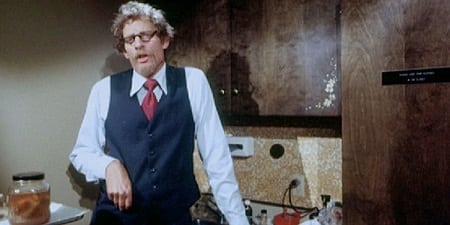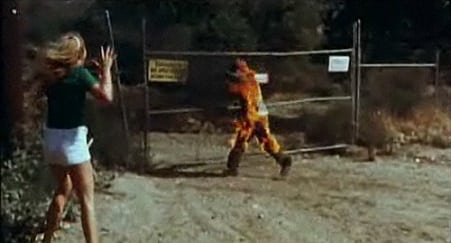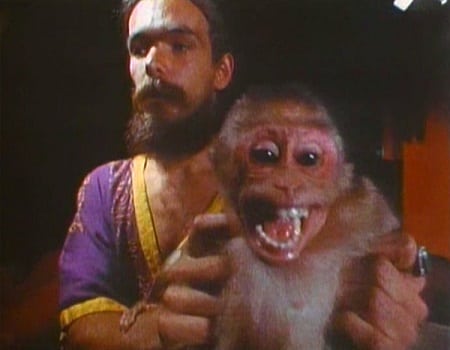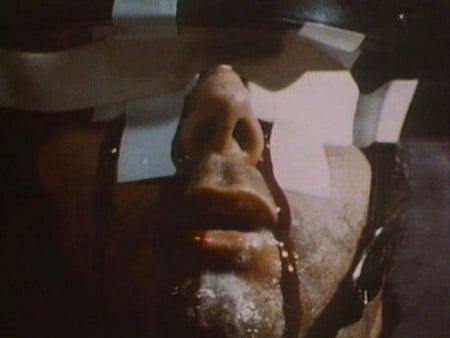Faces of Death (1978)
Directed by: John Alan Schwartz
Written by: John Alan Schwartz
Starring: Michael Carr
Faces of Death (1978)
First Released: September 1982
Director: John Alan Schwartz
Current UK Status: Passed 18 after 2:19s of cuts
Faces of Death is up there with the best known of all the Video Nasties, and to this day remains a cult phenomenon. Naturally the mockumentary, which featured a collection of scenes of real and fake deaths, was added to the Director of Public Prosecutions lists in July 1983. Released in September 1982 by Atlantis Video Productions, it did not take long for Faces of Death to be banned in the UK (and forty other countries according to the advertising) and the film remained on the list throughout the panic, becoming a hugely sought after collectable. It was eventually re-released in 2003 after 2:19s of cuts for its many scenes of animal cruelty.
The director of Faces of Death, John Alan Schwartz, used many different names when it came to writing and even starring in Faces of Death and its numerous sequels. He used the name Conan le Cilaire to direct Faces of Death 1-6, and used the name Alan Black to write them, and finally the bizarre name Johnny Getyerkokov in 1999 for the Faces of Death: Fact or Fiction documentary. Schwartz also famously shared a room with David Hasselhoff at college, where he studied in the theatre department as an undergraduate.
Schwartz worked as a production assistant on the Leonard Nimoy hosted paranormal investigation, In Search Of, and he also worked on episodes for shows like Scandals and Made in the USA. It was when he was editing an animal documentary that the idea of Faces of Death came to him. A Japanese crew had shown an interest in filming death, and Schwartz got to thinking about how to make a film about death, and once he got the idea for the now famous Narrator Dr Francis B. Gross, Faces of Death was born. The first film was commissioned by the Japanese company who loved the idea. From 1978 to 1996 he directed six Faces of Death mockumenatry’s, with parts five and six simply being the best bits from the first four films. Schwartz also wrote the films, and Faces of Death has pretty much become his legacy.
In 1982 he did write episodes for TV series Knight Rider, and he also wrote episodes for TV shows Automan (1983), Santa Barbara (1984), The Fall Guy (1986) and Dragnet (1989). He also wrote the films House of the Rising Sun (1987) and A Passion For Murder (1992). However, Faces of Death continues to control his career, with a constant demand for interviews about the films legacy, and more and more people attached to the film coming forward over the years to explain exactly what went on, Schwartz will forever be the Faces of Death guy, and for good reason, it fascinates people!
Now that Faces of Death is over, the director continues to build on it, and is currently writing memoirs about the making of the film. Schwartz and his wife can also regularly be seen on Youtube giving their thoughts on films as Two Jews on Film.
Those who have seen Faces of Death have plenty to say about it: whether they are complaining about the fake scenes, sickened by the real ones, don’t see the point, or are fascinated by it, the power of Faces of Death cannot be ignored. The film is simply a collection of scenes of death, narrated by the rather creepy Dr Francis B. Gross (Michael Carr), a character who was claimed to have been killed later on in the series, but also claimed to have committed suicide after being surrounded by so much death. He claims to be “called upon” the moment “death occurs”, making him out to be some sort of human Grim Reaper. He also explains that he has a recurring dream about death, and that he is “searching for an understanding”. His mission is to “gain a new perspective from the many faces of death”. Well ahead of its time, Faces of Death achieved this on its first release, magnificently.
Nothing like this had ever been done before, at least not to this magnitude, and the splicing of real and fake footage left audiences at the time believing everything was real, and created a huge panic and disgust among some fans, while others were compelled to watch it, fascinated. Faces of Death, when banned, was the kind of film we would pass around at school, and if you were lucky enough to obtain a copy, everyone wanted to borrow it. Who cares if the copy was barely watchable (it added to the realism), Faces of Death had become legendary, a kind of initiation film that if you could survive you could prove your manliness! Back in the 70’s, 80’s and even 90’s its reputation was legendary, and its legacy forever remembered by horror fans, arthouse fans and those who love exploitative cinema. It is unlikely that the film would have much impact on today’s generation of Youtube fanatics who could probably find much more sickening stuff at the push of a button, but we must not forget that when Faces of Death was released, film information and home videos were not as common place as they are today. This allowed the mockumentary to unleash a ferocious power, and while most would probably be laughed at today, on its release Faces of Death upset a LOT of people, and for good reason.
The opening shots of open heart surgery, autopsy’s and bodies being carved up are hideous, and the muffled voices give the film a real sense of illegal filmmaking. The opening works well to set the scene, and put the viewer on edge, knowing that they are watching something they probably shouldn’t be watching, and that this film warrants a strong stomach. Within minutes we move on to Mexico and see close-ups of frozen Mummies and hideous faces, some of which are clearly fake and created for shock value. The narrator has kicked in by this point, slowly and calmly explaining what we are watching on screen with a morbid fascination, and a macabre sense of wonder in his tone. The narrator works impressively well to give the mockumentary a sense of vile purpose, and if you thought the film was exploitive, then the narrator heightens that fact, and you are left wondering exactly why this even exists. Is it Dr Gross’ disturbing fascination with death that has caused this film to exists, one mans perverted search for all things horrible, or is there a deeper meaning to it all, a political statement to try and change our ways of life? The answer comes later on in the films closing moments, and the narrator does indeed deliver his political message, but the sense of changing our thinking comes very early on, as we get to the infamous slaughterhouse scenes.
The slaughterhouse is a video of what actually goes on, with interviews by actual farmers talking of how they soon become numb to slaughtering their livestock, because if they didn’t then they could not make a living. Fair point, but we cannot numb to watching cows being skinned and slaughtered, a barrage of abattoir shots, and while comical if watching with a group of mates, the shot of a headless Rooster still alive and running around is deeply unsettling. Further on animal cruelty takes control, and provides some of the more disturbing moments of the film: videos of a savage Pitbull dogfight is hard to watch, and quite probably never been filmed before, while videos of brutal seal bashing is very likely to make grown men cry. However, the real is blended with the fake, and the infamous scene involving a small monkey being brought to a dinner table screaming, having its brains smashed in and eaten, is thankfully confirmed by the director as fake. Another scene involving a man eating Alligator is one of those moments you just have to see for yourself. An apparent news reporter caught the Alligator on film attacking a local, but somehow his one camera can take shots from multiple angles, but always manages to cut away right before the action. It is clearly fake, but also a smart idea of how found footage can work really well to trick viewers, and as I said earlier, an idea well ahead of its time. The sheer determination of the filmmakers to make something like this look real has to be applauded, and indeed way back in the 70’s and 80’s, it worked to some extent.
The fake stuff soon becomes apparent, and in a way deters from the disturbing and very real violence of the actual stock footage included. An assassin is interviewed about his job as a hired killer: both his face hidden and voice distorted, but his name appears on screen for all the world to see! A gas chamber death sentence is another faked scene, but again shows just how far the makers were willing to go to get a reaction from its audience. The same can be said about a brutal, but clearly fake electric chair scene which see’s blood trickle down the face of the ‘victim’. For its time, this was regarded as highly upsetting, and made the chilling poster image for the film. Clever not to exploit these death sentences, the narrator talks of curing criminals by putting them through a rehabilitation programme rather than simply killing them. Another political message hidden among a barrage of violent scenes.
The real stuff is where is gets really upsetting, and here is where you have to question the filmmakers intentions. The recurring question will keep on coming to mind: why? Stock footage of the aftermath of a plane crash, a car crash, a man falling from the sky after his parachute fails to open, later scenes of real natural disasters and eventually footage from World War 2 will all disturb, upset and educate in equal measure. The work that has gone in to finding all this stock footage must have been a gruelling task for its time, and so for this reason it is hard to justify this film as simply sick for sicks sake, a simple exploitative movie. If Schwartz and his crew wanted to make a movie simply to upset viewers, they could have faked it all, for they did a good job with the majority of the fake stuff here. So with the effort gone in to finding this stock footage, and learning about it, you could argue that there is a genuine point to all this, and the narrator delivers his final message as the film draws to its conclusion. Dr Gross covers all the issues brought to our attention in the film, and tries to get us to change our ways. Hell there is even a message about leaving your litter on the streets included here!
Whatever the intention was here, Faces of Death does deliver a harsh warning about life in general by way of unforgettable scenes which will lodge themselves in your memory forever. It is very probable that this film turned many viewers vegetarian with its ugly slaughterhouse scenes, and no doubt GreenPeace would have gained some new found respect for saving the Earth after some of the horrific moments seen here. The film makes a point about war, nuclear bombs, concentration camps and even disease! Hell even caving and hiking come into the threats, and there is even a warning about being a pedestrian! Yes, things go too far, and if you were to take everything here seriously you would never leave your house again, so Faces of Death should be taken with a pinch of salt (just make sure you know where the salt comes from!).
Some of the philosophy questions are a little too sugar coated, and some of the warnings about life and our planet a little too ridiculous, but there is no denying that Faces of Death is a fascinating and highly effective watch. Whether you believe in Faces of Death or its message is your choice, but the film at times is highly educational, and can be very motivational. It could be that the director had a hidden agenda, it could be that he accidentally stumbled upon genuine moments of genius, or it could be that the director simply wanted to make a film to upset viewers and generate a legacy that was almost unmatched in the decades that followed. Whatever you take from Faces of Death, remember that at the time it was made NOTHING had ever been seen like it: it is/ was a powerful study of death, a shocking display of human brutality, and a frightening warning of how we are killing our planet.
Faces of Death was probably more dangerous than it ever set out to be, and easily one of the most upsetting films to have ever been made. Clever, smart, at times genuinely upsetting, disturbing, laughable and always willing to go that one step further, Faces of Death is a must-watch for fans of exploitative cinema, serious horror fans and fans of classic filmmaking in general. Maybe Faces of Death really was too smart for its own sake, or maybe the director cleverly tricked us all and is laughing at how those over the years have bought into his sick experiment believing there was a deeper meaning to it all. The decision to believe or not to believe is yours.
Should Faces of Death have been added to the Video Nasty List? Sad to say but yes, even though I do not agree with the banning of films, this was way ahead of its time and extremely difficult for viewers to comprehend. It is a good thing that it is available today, for this is cult filmmaking that deserves to be seen by all those interested.
Rating: 

















Be the first to comment